by Steve Selden | Oct 23, 2016 | Tour News
Natural Habitat Adventures guide Brad Josephs and his band of travelers enjoyed an exciting start to the polar bear season with good bear sightings along with some other fantastic wildlife encounters. The group also witnessed an iconic landmark coming to the ground out in the Churchill Wildlife Management Area.
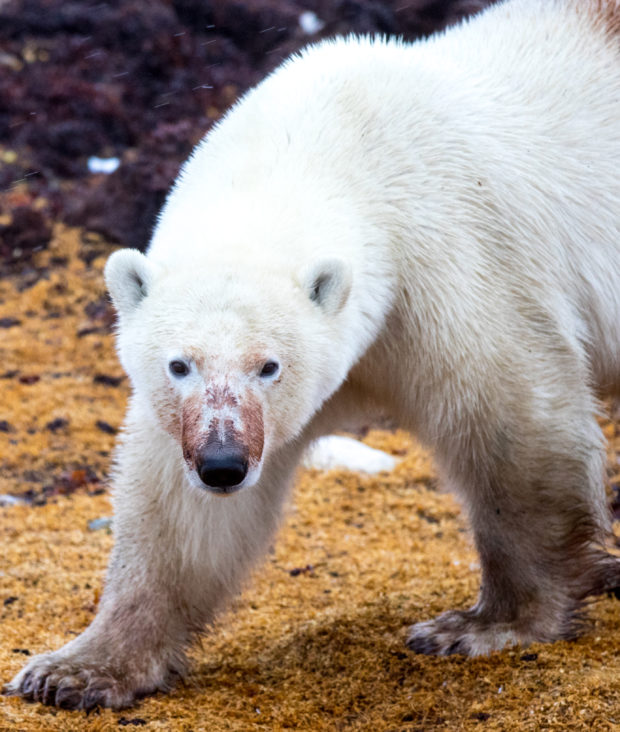
Polar bear with a dirty snout. Brad Josephs photo.
Veteran guide Brad reported warmer than average temperatures for this time of year though that didn’t deter polar bears from revealing themselves on the tundra. A pair of snowy owls perched on Precambrian rocks searching for lemmings or Arctic hares made for prime viewing and photo ops. A small group of willow ptarmigan made their way from the willows, imagine that, into sight of the excited group. A good look at an iconic northern species.
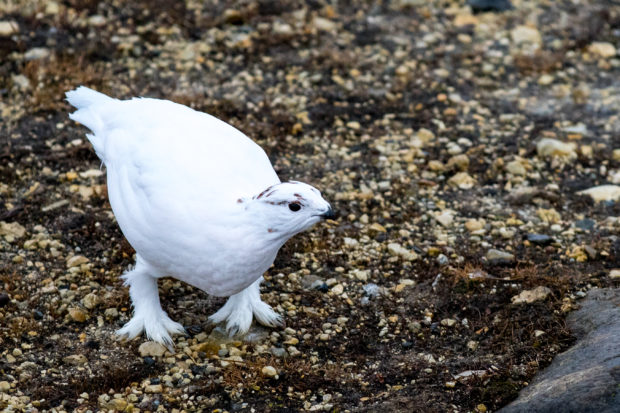
Willow Ptarmigan displaying furry, insulated feet. Brad Josephs photo.
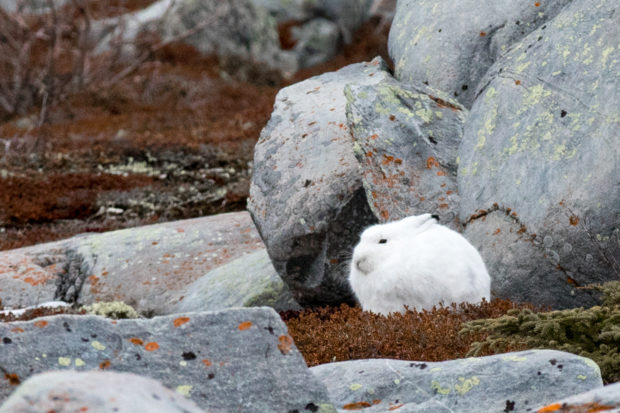
Arctic hare stoic ly waiting for the protection of snow. Brad Josephs photo.
Brad described the falling of an iconic landmark out in the CWMA.; “A strange thing happened while we were on the tundra. We drove by an old military observation tower built in the early 1950’s for cold weather training, and when we drove by it again a few hours later it had collapsed in the high winds.” The landmark was dubbed “first tower” since there were two of these structures built for military training observation in the 1950’s and this one is the first one that polar rovers encounter while searching the tundra for wildlife. It’s quite a ways out on the trail and served as a landmark for rover drivers, especially in snowy conditions. Sad to see it go!

The demise of first tower in the CWMA. Brad Josephs photo.
While exploring the tundra out near the fallen tower, the group had an amazing encounter with a red fox carrying its ptarmigan prey in his mouth. Surprised by being “caught in the act” , the fox paused to take in the curious onlookers gazing at him in wonderment of the laws of nature and the survival chain of life in the Arctic wild. What an exciting start to the 2016 polar bear season in Churchill!
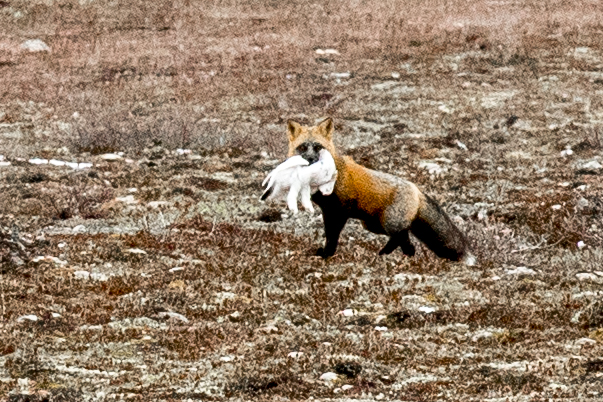
A red fox with a tasty meal of willow ptarmigan. Brad Josephs photo.
by Steve Selden | Oct 19, 2016 | Tour News
A fresh snowfall greeted the first ultimate polar bear trip for Natural Habitat Adventures guide Moira Le Patourel and her group of travelers to Churchill. The fresh, light snow allowed for wildlife track sightings of fox and polar bears and even a lone wolf trail heading into the boreal forest. Typical temperatures for October, hovering around freezing, have allowed for more active polar bear activity on the tundra.
A quite intriguing polar bear interaction a couple of days into the expedition was witnessed by a few groups out in the Churchill Wildlife Management Area (CWMA). A large older juvenile, about 3 years – old, was interacting intimately with what appeared to be mom. Polar bear cubs usually spend around two years with their mother
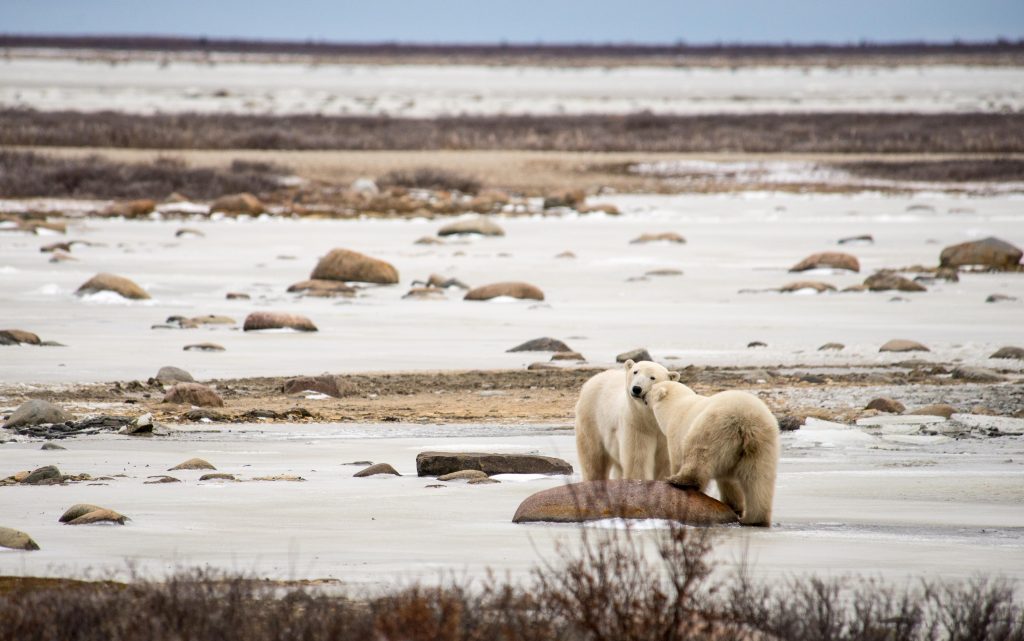
Mother polar bear and unusually older cub getting close on the tundra. Moira Le Patourel photo.
Another unique, although more common sighting this season, was a onyx – colored fox, typically referred to as a silver fox scouring the snow covered tundra searching for lemmings below. This blackish and silver mix is a color morph of the common red fox and the contrast on the white covered tundra is striking. No camouflage here like the pure white Arctic fox. This guy won’t be sneaking up on any prey soon.
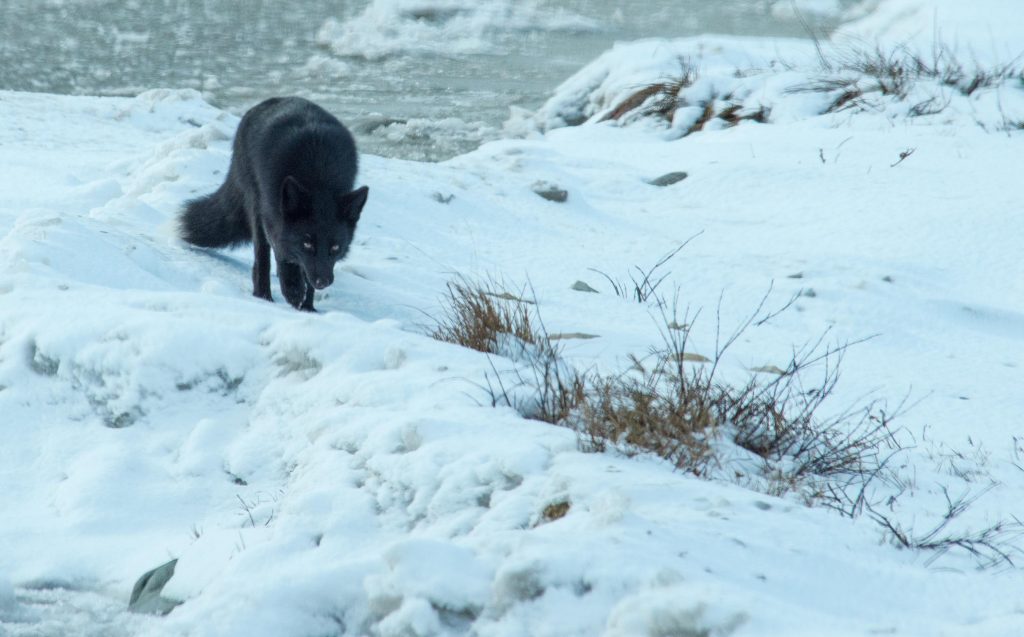
A color morph of the red fox, this onyx shaded fox is on the prowl for a meal of some sort. Moira Le Patourel photo.
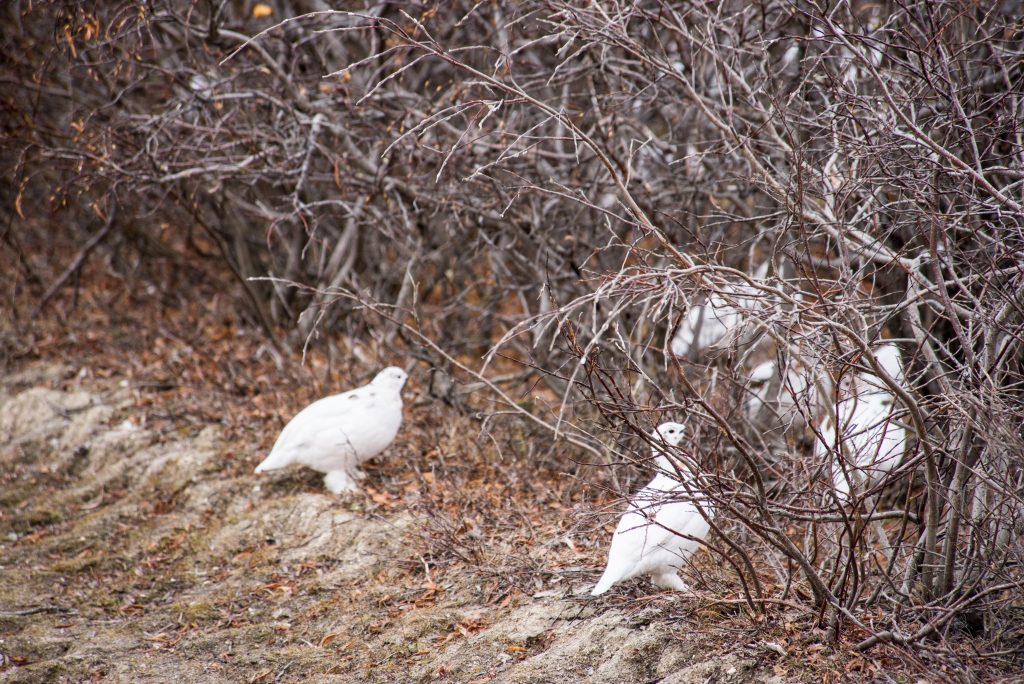
Willow ptarmigan next to the rover trail in the CWMA. Moira Le Patourel photo.
Other sightings of a traditional colored red fox as well as an Arctic fox completed the trifecta. A grouping of white coated willow ptarmigan were spotted heading into and out of the willows by the rover trail. On another rover trip to the tundra and CWMA the group witnessed a male polar bear with a purplish marking on his white back – end. The bruin most likely had been snoozing in a kelp bed with some purple – hued varieties intertwined. A funny and unusual sight for sure.
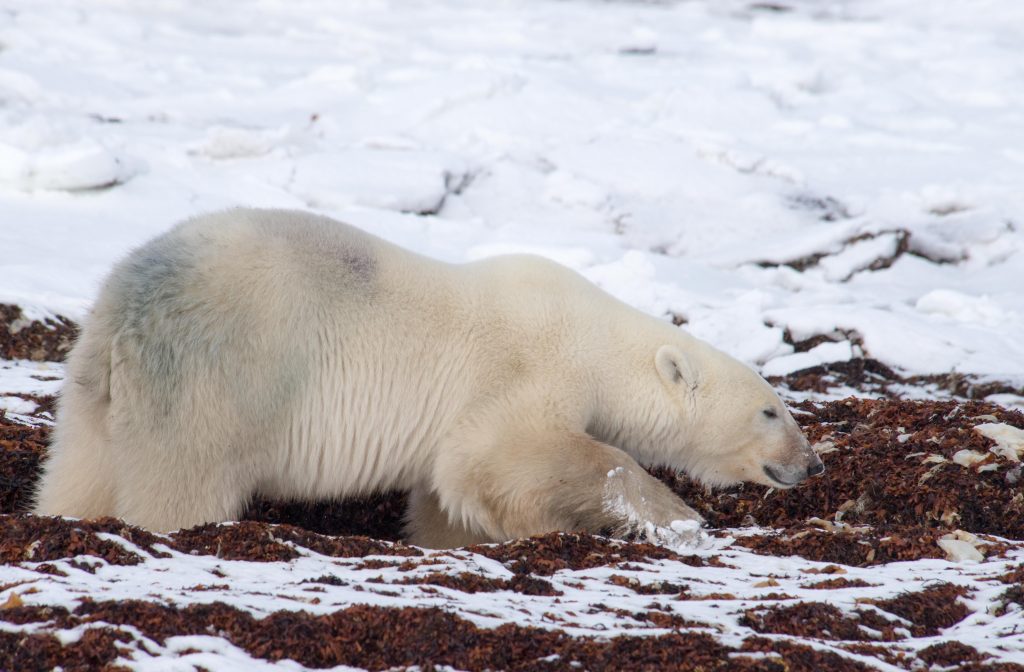
Polar bear settling in a kelp bed. Moira Le Patourel photo.
Equally as rare and unusual was a polar bear gnawing on what appeared to be a snow goose wing. A small amount of energy exhausted to gain a few vital grams of protein. Any sustenance between now and the freeze over of the Hudson Bay will be crucial to survival for any polar bear.
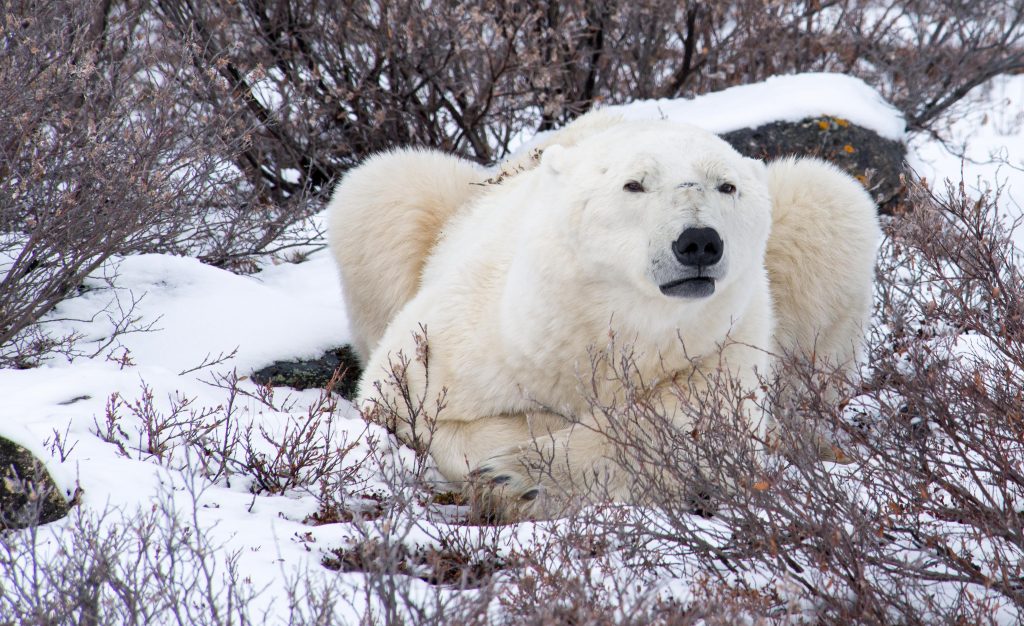
Polar bear with a gull goose wing watching out cautiously. Moira Le Patourel photo.
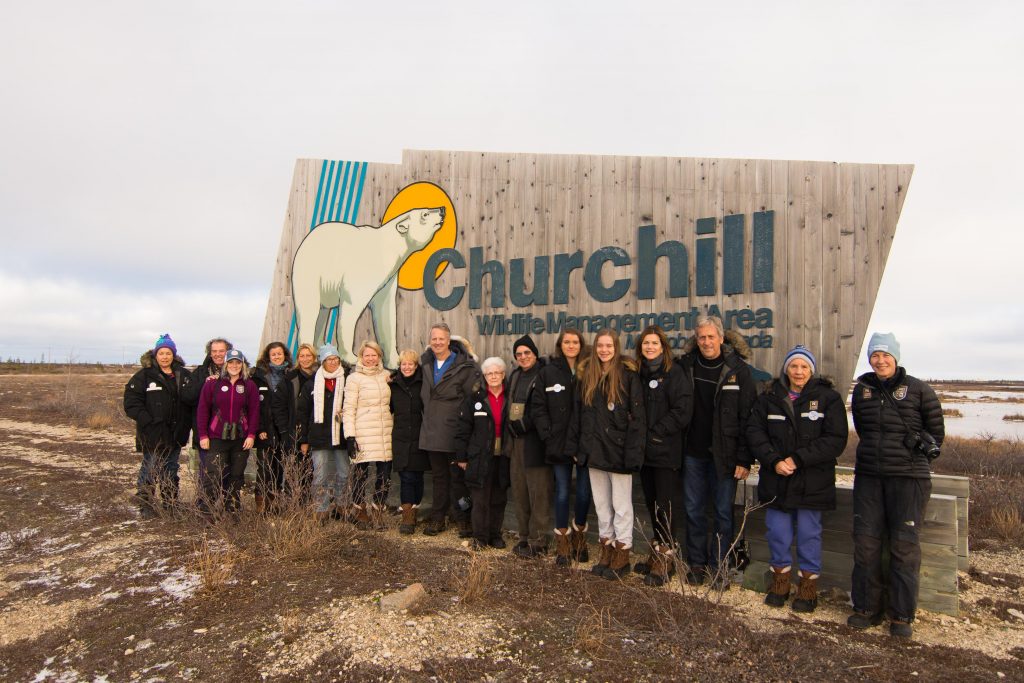
Natural Habitat group of travelers in the CWMA. Moira Le Patourel photo.
by Steve Selden | Oct 17, 2016 | Tour News
The exciting news from Churchill is polar bears have been spotted out at the Tundra Lodge in the Churchill Wildlife Management Area (CWMA) and they are becoming more active as the season begins here. The first Natural Habitat Adventures group at the lodge guided by Colby and Eric came quite close to a big male bear out by first tower as their group explored away from the base lodge on a rover. A few others lounged around the lodge moving about the willows.
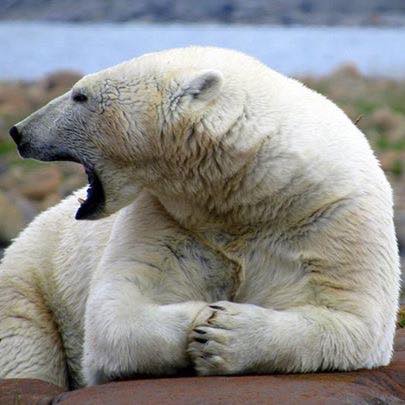
Majestic polar bear resting in Churchill. Katie DeMeulles photo.
More exciting news from polar bear season Churchill is there are still at least 30 – 40 beluga whales still lingering around the mouth of the Churchill River and along the coast in the Hudson Bay. Some travelers took a helicopter journey and spotted the beluga pods below..what a sight for this late in the fall! I imagine there will be some more time for beluga’s here though soon they will depart for the Hudson Straits up north.
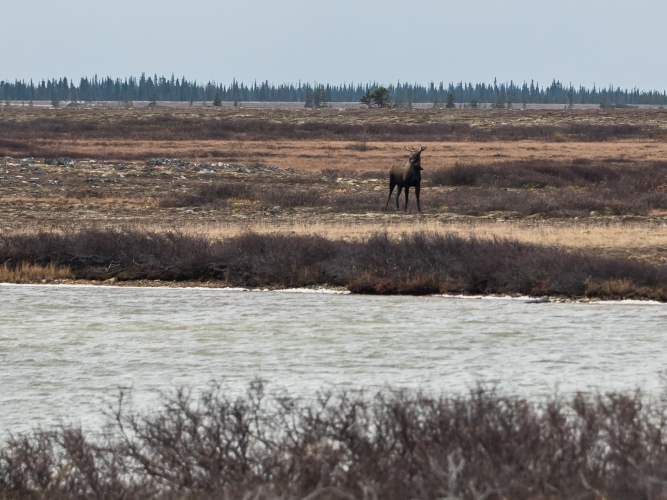
Moose on the tundra in Churchill. Madison Stevens/PBI photo.
Other sightings by our friends at Polar Bears International (PBI) included numerous black foxes- a color morph of the red fox – as well as traditional colored red foxes. A couple of Arctic fox have been spotted as well. Ptarmigan, Arctic hares and numerous bird species have also filled out the wildlife sightings for travelers over the past week. PBI travelers also were surprised by a large moose galloping along the tundra between ponds out in the CWMA!
Northern lights made an appearance on a couple of nights and were some of the best since last aurora season in February. Greens and pinks shimmered across the tundra in the darkened sky of the CWMA.
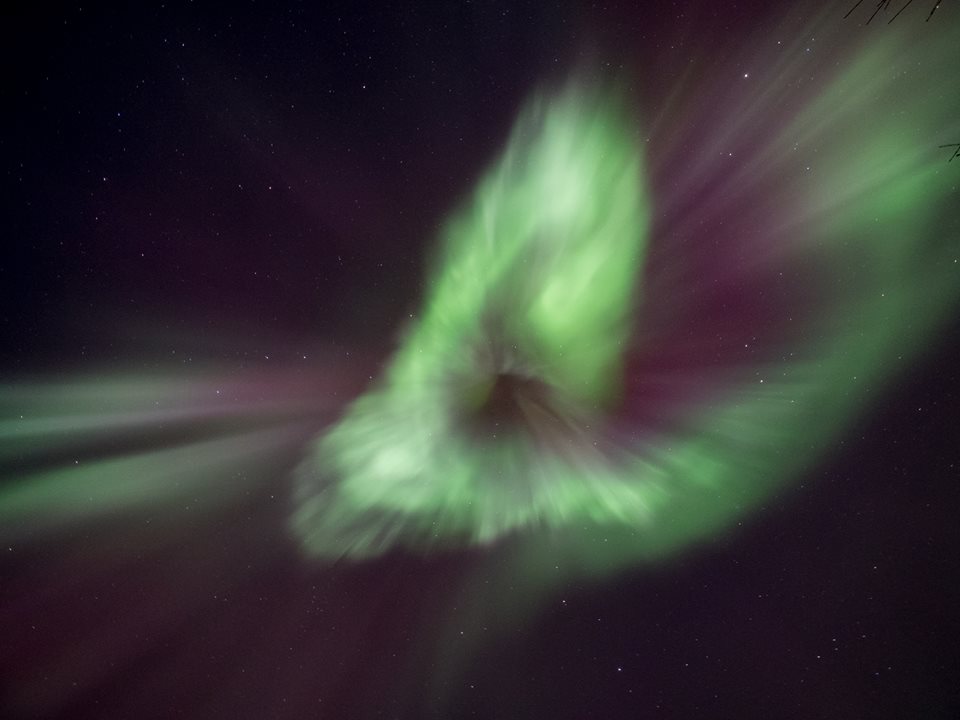
Intense northern lights in Churchill. Drew Hamilton photo.
Perhaps the most incredible sighting was also by the PBI group. They witnessed a Peregrine falcon feeding on a gull on the fringe of the willows. They observed the web of nature and the life-cycles of these hearty creatures firsthand!
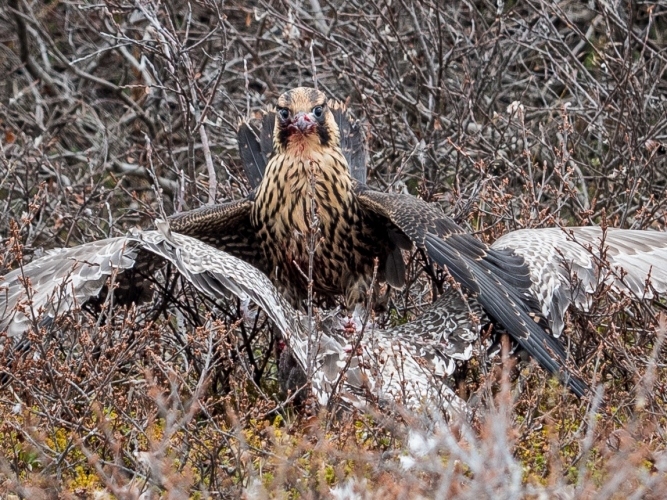
Peregrine falcon feasting on prey of a gull. Madison Stevens/PBI photo.
We are only in the first full week of polar bear season and already are witnessing surprises from every area out on the tundra!
by Steve Selden | Aug 19, 2016 | Tour News

Beluga whales would be adversely affected by oil spills in the Arctic. Alex De Vries – Magnifico photo.
The Province of Manitoba provided the final piece of the funding puzzle this week with a $9 million dollar pledge toward the projected $32 million Marine Observatory in Churchill. The main focus of the research carried out at the center will be on oil spills in the north and subsequent mitigation as well as prevention. Fragile Arctic and sub – Arctic wildlife and ecosystems will depend upon protection provided through this research station.
Lead scientist David Barber, a professor at University of Manitoba and Canada Research Chair in Arctic systems science, summarized the process leading up to this important announcement; “Everybody’s provided their funding, the project’s moving forward,” he stated. “We just need to finalize who’s going to build the thing. In the next 12 months we hope to get the building put together, functional and operating so it can be used for science .”
The funding will funnel through the University of Manitoba, the lead entity in this venture. A number of western Canadian universities and groups are involved in the massive coordination of budget and vision of the observatory. Manitoba’s commitment brings them all in line now.
With the recent closure of the Port of Churchill by US based Omnitrax, this announcement is a move in the right direction for the town of Churchill and prospective work – force. “This project is an important part of our vision for a strong, diversified northern economy,” stated Ian Wishart, the province’s Education and Training Minister.

Conceptual drawing of the Churchill Marine Observatory. Juliana Kusyk image.
“The Churchill Marine Observatory will create up to 21 permanent jobs, boost tourism and transportation in the region and enhance Manitoba and Canada’s reputation as a world leader in Arctic research,” added Wishart.
The project’s fundraising began in 2014 with three universities led by U of M applying to the Canadian Foundation for Innovation for almost 40 per cent of the needed $31.7 million. Manitoba, Aberta and British Columbia have contributed nearly $12 million with Manitoba being the stalwart at $9 million.
About 20 scientists will be based at the center in Churchill studying potential effects of oil and industry in the Arctic. Upon completion the Churchill Marine Observatory will provide a year – round base for new technology development and scientific research in the north. Universities from north America and Europe will utilize the center for student and faculty training and research as well.
by Steve Selden | Aug 15, 2016 | Tour News
Natural Habitat Adventure’s Churchill Arctic summer trips are winding down and guide Moira LaPatourel submitted these images from the last trip. Looks like a group of happy travelers experienced all kinds of northern fun in Churchill! While polar bear activity has calmed down some from a couple of weeks ago, the tundra still reveals all the treasures of late summer as berries and other wildflowers are squeezing all they can out of the short growth season. Beluga whales in record high numbers have been all throughout the estuaries this summer. Last year some belugas were still present at the start of polar bear season in October and by the looks of this summer we may have a repeat of that this year.
This has been one of the most successful Churchill Arctic summer seasons on record with bears and belugas in prolific numbers. With all the supporting scenery and wildlife, this Churchill Arctic summer will be etched in many traveler’s memories!

The stark coastline of the Hudson Bay in the distance. Moira LaPatourel photo.

A Natural Habitat group bonfire behind the town complex by the Hudson Bay. Nothing like a nice wine and cheese gathering to bond a group together. Moira LaPatourel photo.

The hard – to – find Samuel Hearne etching along the Cape Merry path. Moira LaPatourel photo.

Beluga whales frolicking in the Churchill River. Moira LaPatourel photo.

The amazing polar rover escorts Natural Habitat groups out to the coast in the Churchill Wildlife Management Area. Moira LaPatourel photo.
by Steve Selden | Jul 5, 2016 | Tour News
Tiffany Spence in Churchill took this spectacular underwater beluga whale video and the crystal clear water gives us a perfect view of the milky white mammals. This is the time to get in the water with these beautiful animals and see what it feels like to be an Arctic whale. Snorkeling with the belugas is a once in – a – lifetime experience that will stay with you forever!























